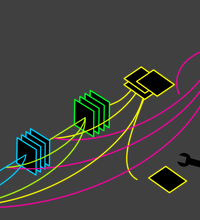
Towards Explaining the Regularization Effect of Initial Large Learning Rate in Training Neural Networks
Tengyu Ma
Room 116
Stochastic gradient descent with a large initial learning rate is a widely adopted method for training modern neural net architectures. Although a small initial learning rate allows for faster training and better test performance initially, the large learning rate achieves better generalization soon after the learning rate is annealed. Towards explaining this phenomenon, we devise a setting in which we can prove that a two-layer network trained with large initial learning rate and annealing provably generalizes better than the same network trained with a small learning rate from the start. The key insight in our analysis is that the order of learning different types of patterns is crucial: because the small learning rate model first memorizes low noise, hard-to-fit patterns, it generalizes worse on higher noise, easier-to-fit patterns than its large learning rate counterpart. This concept translates to a larger-scale setting: we demonstrate that one can add a small patch to CIFAR-10 images that is immediately memorizable by a model with small initial learning rate, but ignored by the model with large learning rate until after annealing. Our experiments show that this causes the small learning rate model’s accuracy on unmodified images to suffer, as it relies too much on the patch early on.


